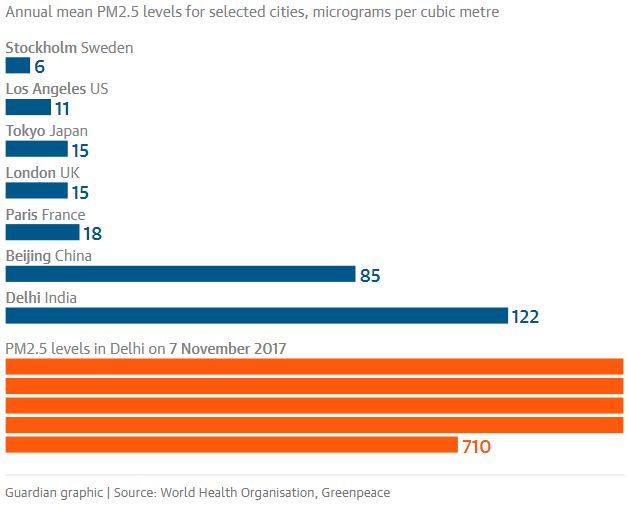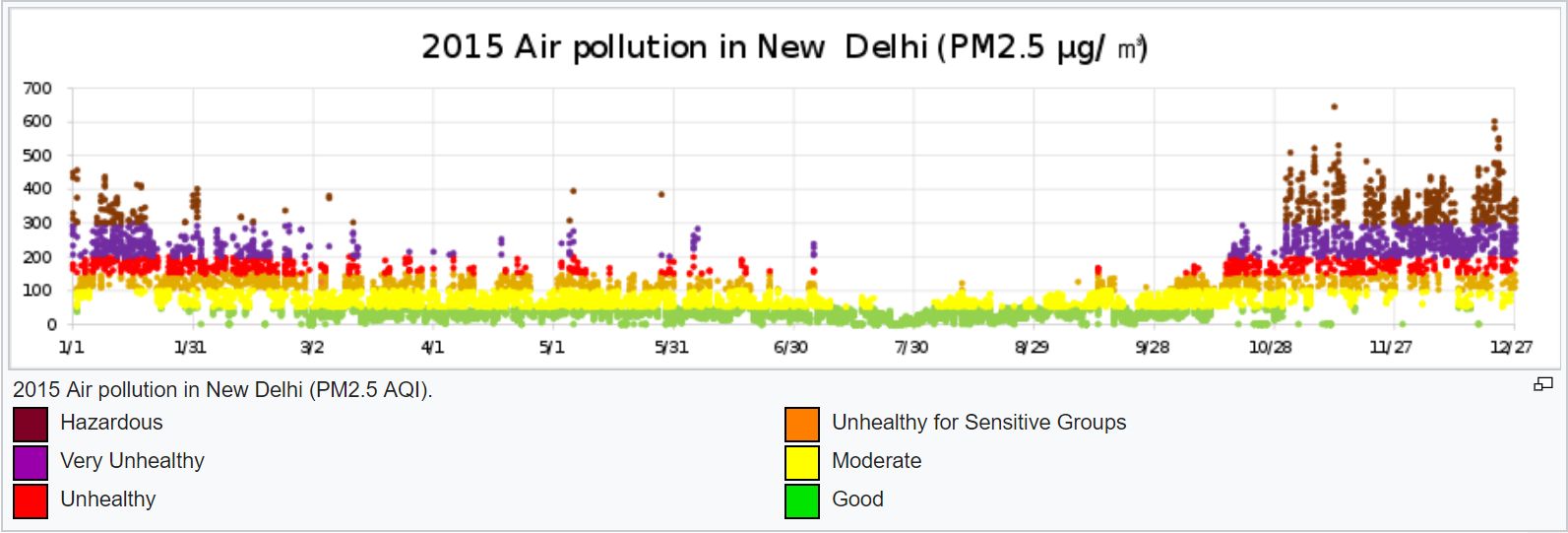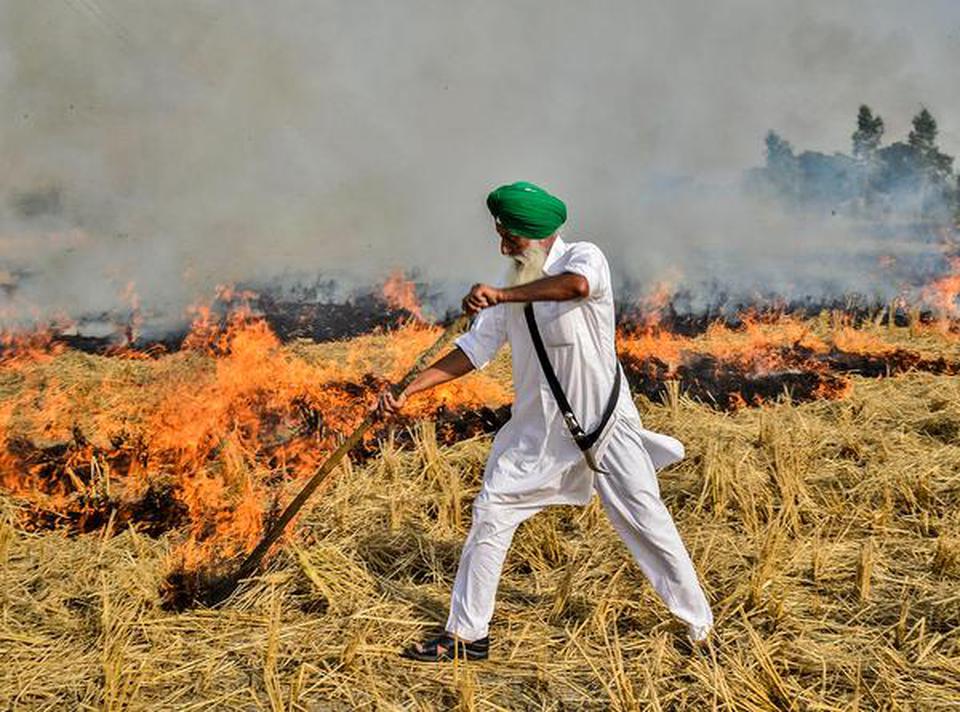Suffocating airpocalypse in New Delhi
Sentinel-3 OLCI FR acquired on 17 October 2017 at 05:08:26 UTC
...
Sentinel-2 MSI acquired on 22 October 2017 at 05:28:39 UTC
...
Sentinel-3 OLCI FR acquired on 10 November 2017 at 04:45:59 UTC
...
Sentinel-2 MSI acquired on 22 October 2017 at 05:28:39 UTC
...
Sentinel-3 OLCI FR acquired on 10 November 2017 at 04:45:59 UTC
Keyword(s): atmosphere, air pollution, air quality, smog, land, urban growth, public health, energy, Himalaya, Pakistan, India.

source
Wednesday 08.11.2017, New Delhi breached the level of 1000 µg/m3 PM2.5 (Particulate Matter < 2.5µm) with its Air Quality Index saturated at 999, to compare with the World Health Organisation (WHO) guideiines regarding Air Quality Index that are set to 10 µg/m3 PM2.5. Sébastien Farcis, foreign correspondent in Delhi for Radio France Internationale (RFI) commented that it was difficult to see the sun, even at full daylight. He added that staying outside was dangerous even for healthy people and that homes were not spared but the smog either. Visibility was so low that airport Indira Gandhi was temporarily closed according to RTL.

A woman drives a scooter through the morning fog to drop off a child to school near New Delhi on Thursday 9.11.2017 - by R S Iyer for Associated Press
New Delhi is unfortunately accustomed to high pollution level. WHO found out it was World's most polluted city in 2014. Even though they are too expensive for the layman, the city ran out of masks. The 06.11.2017, even before pollution had reached its maximum, Arvind Kejriwal, Delhi's chief minister, wrote on Twitter: "Delhi has become a gas chamber. Every year this happens during this part of year. We have to find a soln to crop burning in adjoining states".


Source graph based on reports provided by US Consulate in New Delhi.
Breathing in air with a PM2.5 content around 1,000 is considered roughly equivalent to smoking 45 cigarettes a day, according to the independent Berkeley Earth science research group, while The Guardian reported that: "Dr Arvind Kumar, the chest surgery chairman at Sir Ganga Ram hospital, compared the 999 AQI level to smoking 50 cigarettes in a day". A quick calculation indicates that each hour breathing in such in atmosphere implies inhaling 0.5g of PM2.5.
Consequences on public health are dire, compiling statistics published in an article written by Prof Philip J Landrigan for
The Lancet, Brady Dennis wrote in The Washington Post: "In 2015, the largest number of deaths attributable to pollution occurred in India and China, with an estimated 2.5 million and 1.8 million deaths respectively. Other severely affected countries include Pakistan, Bangladesh and Kenya.". Prof Philip J Landrigan commented: "Pollution control can stimulate the economy because it reduces death and disease.". His article estimated the hit to national budgets at about 1.3 percent of gross domestic product in low-income countries, compared to about 0.5 percent in developed, high-income countries.


Global death rate attributable to pollution
The Guardian reminds some of the reasons of these recurrent phenomenons: "Delhi’s air quality is extremely poor for most of the year due to road dust, open fires, vehicle exhaust fumes, industrial emissions and the burning of crop residues in neighbouring states. But conditions worsen in winter months when slow winds and cool temperatures trap pollutants closer to the ground."
Regarding the climate, Jean-Joseph Boillot, adviser at the French research center in international economics added RFI the region reverts to a semi arid climate after the monsoon season. When wind is strong, loose soil from Rajasthan & Penjab provinces is then likely to produce sandstorms which transports fine particles to New Delhi region.
Diwali, the Hindu festival of lights is also commonly accused. On the third day of this five-day festival, Lakshmi Puja, people place lights around their home and light up fireworks, in particular children. The large quantity of fireworks used produces heavy smoke in all cities. During the automn, low wind conditions are likely to cause the smoke to stagnate on urban centres.

Credit: Madhumitha Srinivasan & Mohd Arif for The Hindu: "We cannot imagine a Diwali without fireworks; its colours paint the skies and sounds fill our ears. The most popular of the lot are rockets, flower pots, chakras, sparklers and the noisy “bombs” that come packed in varying decibels."
A rising cause of concern is the pollution caused by transport. There are 10 millions motor vehicles in New Delhi metropolis, which of 3 millions cars, and 2000 new each day. As long as cars are seen as an expression of social status, it is unlikely Indians choose greener car models or modes of transport according to Jean-Joseph Boillot. According to a one-year study of India Meteorological Department, New Delhi and Bombay share a high all-year pollution level, unlike the more seasonal PM2.5 pollution which can be attributed to motor vehicles. It is likely that improved fuel refining in 2020 reduces this pollution.
Another source of pollution in this 40-million inhabitants region are the 13 thermal power plants, which of 8 coal fired power stations using 70s chinese technology without filters.
Jean-Joseph Boillot also underscores the lack of waste management in New Delhi region, meaning inhabitants burn their waste everyday, generationg offensive fumes.
Finally, one of the worst offender is often considered to be crop burning, regardless of its ban since 2015. Vikas Vasudeva explains the phenonmenon in The Hindu: "After harvest, around 19.7 million tonnes of paddy straw is left on the fields and has to be disposed of to make way for wheat. Of this, 70-75% of paddy straw is burnt in open fields to clear the land for sowing wheat or other crops — it is the quickest and cheapest way of getting rid of the residue. “I stopped burning paddy crop four years back. While clearing the residue from the farm does add to the cost, benefits derived by not burning the crop residue are far more in the long run,” says Sukhwinder Papi, a Sangrur-based farmer who adopted organic farming around four years ago in four acres of his 10-acre holding. Papi adds that burning crop residue in the field kills friendly pests and damages soil fertility. “I have been economically managing paddy residue and using it for composting, besides as dry fodder for cattle,” he says.".

A farmer burns paddy residue on the outskirts of Patiala. Photo Credit: Akhilesh Kumar
Authorities are taking reinforced actions to limit these extreme episodes. In 2014, Rishi Iyengar wrote in Time: "Several steps have been taken to reduce the number of Indian automobiles running on diesel, and the country’s National Green Tribunal also announced on Thursday that it would ban any vehicles older than 15 years from New Delhi’s roads."
For the current environment emergency, Vidhi Doshi wrote for The Washington Post that "the government introduced a slew of emergency measures, including shutting down a coal-fired power plant and polluting brick kilns".
Michael Safi added for The Guardian that "As awareness of the problem in Delhi has grown, various methods have been tried to clear the atmosphere including traffic rationing and banning firecrackers during Diwali, the annual Hindu festival."
Finally, interviewed by RFI, Sébastien Farcis, added that trucks had been temporarly banned from New Delhi, construction sites have been closed, school have been closed to protect children and parking price have increased fourfold.

Launched the 13 October 2017, Sentinel-5 Precursor and its sensor TROPOMI could be a breakthrough for air quality sciences.
TROPOMI is expected to deliver daily measures of particles and pollutants for aerosol, carbon monoxyde, formaldehyde, methane, nitrogen dioxyde, ozone and sulfur dioxyde. A better understanding of the sources and effect of air pollution should allow authorities to take more efficient actions to improve air quality.










